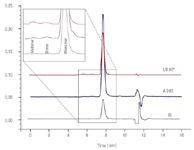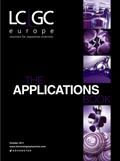Efficient SEC–UV-RI-MALS Analysis of Protein Aggregates
Tosoh Application Note
Static light scattering in combination with size exclusion chromatography is a valuable tool for verifying purity of monoclonal antibodies (mAbs) as such or as a quick check while the downstream processing takes place. Besides fluorescence detection, light scattering is one of the most sensitive methods to detect protein aggregates.
As a matter of their size, mAb aggregates produce scattered light more efficiently than they absorb UV light at 214 or 280 nm. Nevertheless, light scattering is not a plug and play technique, compared to simple UV detection. This application note provides some advice that may help to improve the signal-to-noise ratio and the robustness of the complete system. First of all, it is important to keep the whole system clean and to refresh the eluent frequently. Buffers without sodium azide should be changed daily. At least for protein applications, sodium azide does not cause any problems in the scattering signal. Therefore it is recommended to add 0.05% sodium azide to aqueous buffers in order to prevent bacterial growth. When working with organic solvents, proper degassing of the eluent is essential.
However, any eluent, either organic or aqueous, needs to be filtered thoroughly. Air bubbles and small particles will not be detected by UV but will disturb the light scattering signal. Changing in-line filters regularly, as well as filtering buffers through a 0.1 µm membrane prevent noisy baselines. Detector contamination due to impurities of the sample as such appears frequently. In this case, the system without the column should be rinsed with water containing 1% SDS for 4–5 hours, followed by a quick purging step with water and an overnight washing step with a mixture of 20% ethanol 80% water. Against persisting noise the system can be flushed with a sample degrading solvent. Proteases for instance might help when working with proteins.
Noise generated by the HPLC column can be reduced by cleaning the column as described in the manual delivered with the column. Overloaded columns also release sample molecules independent from retention time, causing a noisy and drifting baseline. The TSKgel SWxl series can be cleaned efficiently by flushing overnight with 0.1 M Glycine/HCl buffer pH 3. The system flow-rate also affects the noise level and should only be changed gradually. Equilibrating the column with 4–5 column volumes at operational flow stabilizes the baseline.
In fact, static light scattering is a multi-detector measurement. Therefore the concentration source, which is usually either UV absorption or the refractive index, is also important. Sodium azide absorbs UV at wavelengths typically used for protein detection. Hence it is recommended using the RI-Signal as source of concentration, also because the refractive index increment is approximately the same for all proteins. Nevertheless the RI-signal does have disadvantages, too. It is prone to solvent peaks, which disable measurements of molecules with the same retention time. Solvent peaks can be reduced by preparing samples in daily refreshed system solvent. Similar to the solvent peak, the injection peak is not related to the sample itself. The injection peak can be decreased by slowing down injection speed.
In general the light scattering instrument is the first to indicate any unsteadiness in the system. System suitability tests with a standard sample can be used to check the system performance before starting an analysis sequence. Once the performance is ensured, an additional light scattering detector provides valuable information about the presence and structure of protein aggregates and the monomer itself as shown in Figure 1.

Figure 1: SEC-UV-RI-LS analysis of a monoclonal antibody. Column: TSKgel G3000SWxl, 5 µm, 7.8 mm i.d. à 30 cm L; flow-rate 1 mL/min; mobile phase: PBS; inj. volume 20 µL; detection: 90° LS (red), RI (grey) & UV @ 280 nm (blue); HPLC system: LC-20A prominence, Shimadzu; MALS detector: miniDAWN TREOS, Wyatt Technology Corp.
Tosoh Bioscience GmbH
Zettachring 6, 70567 Stuttgart, Germany
tel: +49 711 13257 0 fax: +49 711 13257 89
E-mail: info.tbg@tosoh.com
Website: www.tosohbioscience.com

New Method Explored for the Detection of CECs in Crops Irrigated with Contaminated Water
April 30th 2025This new study presents a validated QuEChERS–LC-MS/MS method for detecting eight persistent, mobile, and toxic substances in escarole, tomatoes, and tomato leaves irrigated with contaminated water.
University of Tasmania Researchers Explore Haloacetic Acid Determiniation in Water with capLC–MS
April 29th 2025Haloacetic acid detection has become important when analyzing drinking and swimming pool water. University of Tasmania researchers have begun applying capillary liquid chromatography as a means of detecting these substances.

.png&w=3840&q=75)

.png&w=3840&q=75)



.png&w=3840&q=75)



.png&w=3840&q=75)


















